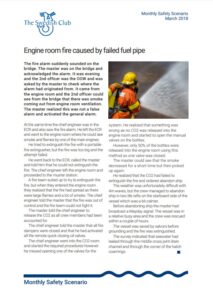In its latest Monthly Safety Scenario, the Swedish Club presents an incident of engine room fire caused by the emergency quick acting valves not being properly closed. Many fires are caused by hot spots not being covered by the required insulation which might have been removed during maintenance.
The incident
The fire alarm suddenly sounded on the bridge. It was evening and the 2nd officer was the OOW and was asked by the master to check where the alarm had originated from. It came from the engine room and the 2nd officer could see from the bridge that there was smoke coming out from engine room ventilation. The master realized this was not a false alarm and activated the general alarm. At the same time, the chief engineer left the ECR and went to the engine room where he could see smoke and flames by one of the main engines. He tried to extinguish the fire with a portable fire extinguisher, but the fire was too big and the attempt failed. He went back to the ECR, called the master and told him that he could not extinguish the fire. The chief engineer left the engine room and proceeded to the muster station.
A fire team suited up to try to extinguish the fire, but when they entered the engine room they realized that the fire had spread as there were large flames and a lot of smoke. The chief engineer told the master that the fire was out of control and the fire team could not fight it. The master told him to release the CO2 as all crew members had been accounted for.
The chief engineer told the master that all fire dampers were closed and that he had activated all the remote quick closing oil valves. The chief engineer went into the CO2 room and started the required procedures however he missed opening one of the valves for the system. He realized that something was wrong as no CO2 was released into the engine room and started to open the manual valves on the bottles. However, only 50% of the bottles were released into the engine room using this method as one valve was closed. The master could see that the smoke decreased for a short time but then picked up again.
He realized that the CO2 had failed to extinguish the fire and ordered abandon ship. The weather was heavy with 4m waves, but the crew managed to abandon ship in two life rafts on the starboard side of the vessel which was a bit calmer. Before abandoning ship the master had broadcast a Mayday signal. The vessel was in a relative busy area and the crew was rescued within a couple of hours. The vessel was saved by salvors before grounding and the fire was extinguished. The survey indicated that seawater had leaked through the middle cross joint drain channel and through the corner of the hatch coamings.
Safety issues According to the Club, following investigation, the following conclusions were made: Explore more herebelow:





























































